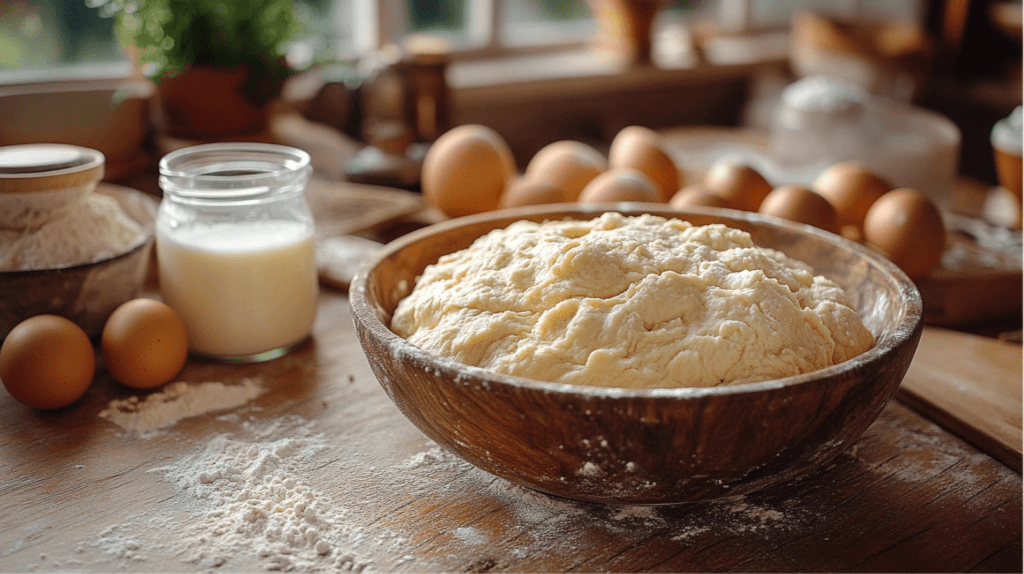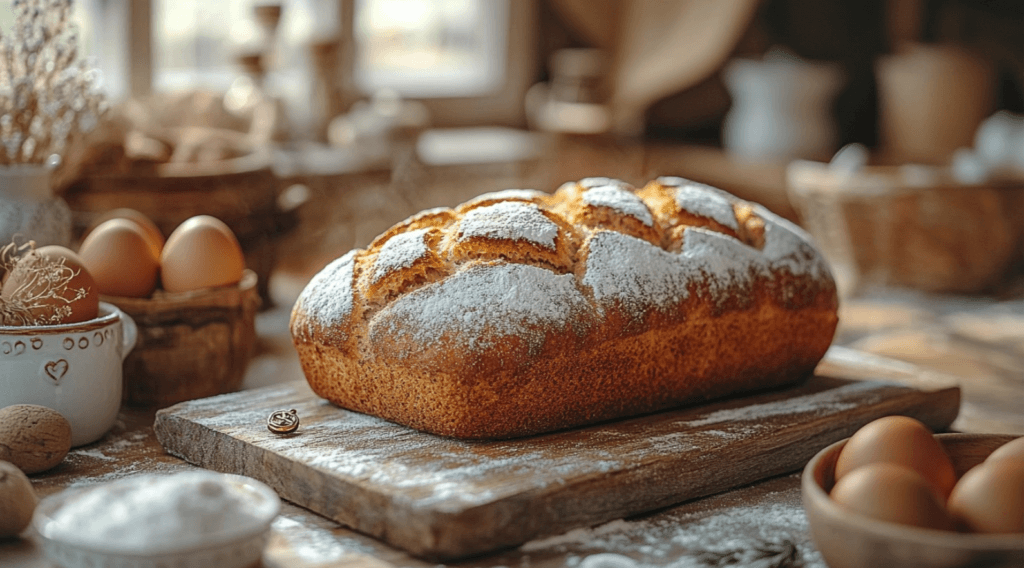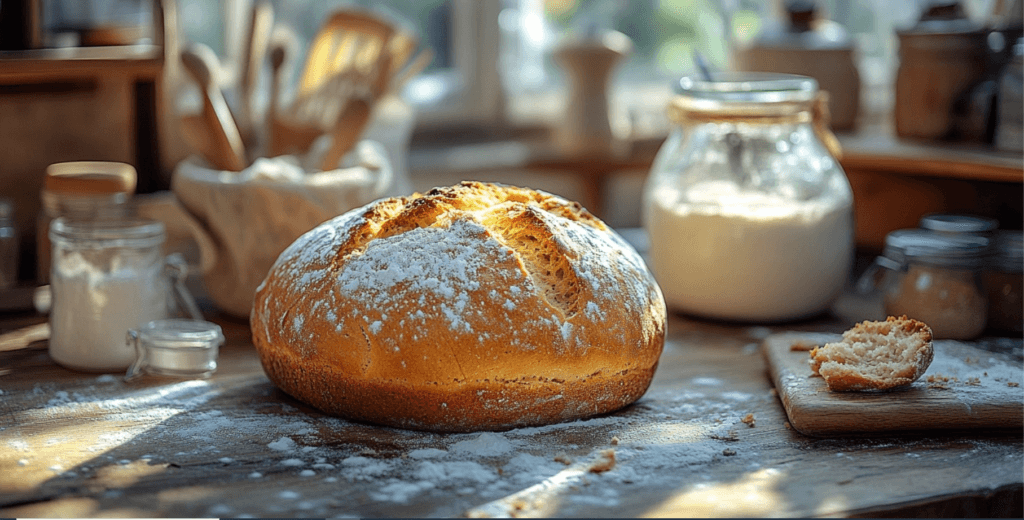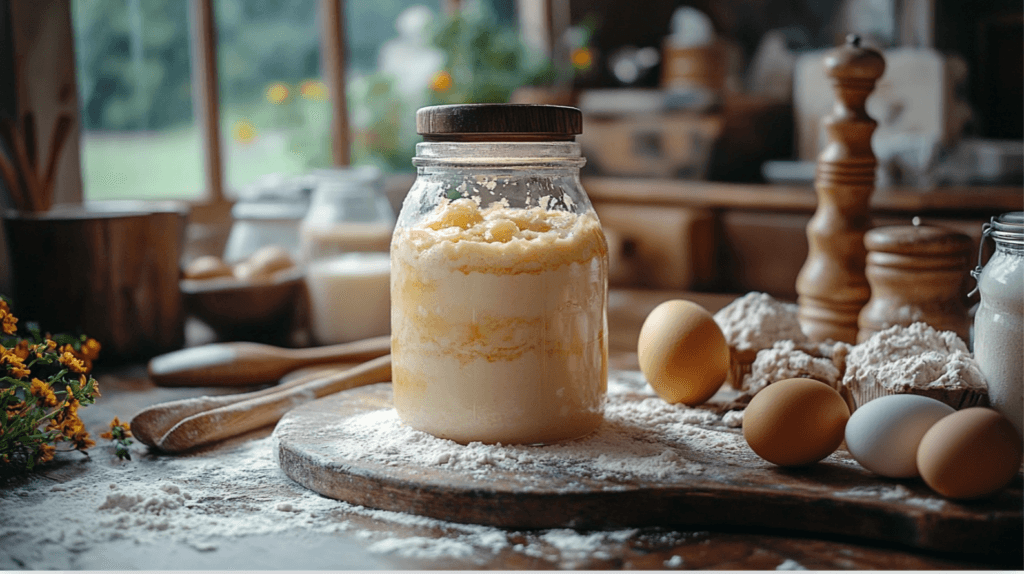Ever got a mysterious package from a friend with a bubbly starter and a bread recipe? That’s Amish Friendship Bread. It’s a tradition that brings people together, showing the value of friendship and community. It’s more than baking; it’s about sharing joy and connection.
Main Highlights
- Amish Friendship Bread is a unique sourdough bread steeped in Amish community values
- The tradition involves sharing a yeast-based starter among community members
- The recipe has evolved, with bakers incorporating a variety of ingredients
- Amish Friendship Bread is a symbol of generosity, interconnectedness, and the joy of sharing
- The bread’s history reflects the Amish emphasis on simplicity and traditional baking methods
The Origins and Cultural Significance of Amish Friendship Bread
Amish Friendship Bread comes from the Amish community culture. It shows the kitchen heritage of this tight-knit group. The idea of “Gemeinschaft” is at the heart of Amish tradition. It’s a deep sense of community that shapes their lives, including their Amish bread origins.
Sharing the Amish Friendship Bread starter is a symbol of their values. It shows their togetherness and support for each other. The starter is passed around, letting each person bake and share with others.
Bread is very important in Amish culture. It stands for care, solidarity, and strength, especially in hard times. Keeping the starter alive and baking bread is a way to keep their traditions alive. It also helps build strong bonds between people.
Amish Friendship Bread has become more popular in recent years. The internet and social media have helped spread it worldwide. But its true spirit stays with the Amish values of simplicity and sharing. They believe that sharing bread can bring people closer together.

Why is it called AFB
The name “Amish Friendship Bread” comes from sharing the starter with friends and neighbors. This shows the Amish values of community and generosity. It’s also known as Amish Cinnamon Bread because of its cinnamon flavor.
The Amish started this tradition with their sourdough starter. They shared it to keep the community close. This way, they showed the joy of bread-making together.
Sharing the starter helped spread the joy of baking. It also showed the Amish value of close relationships. This tradition is a big part of Amish culture, showing their values and way of life.
Now, people all over the world make AFB. They enjoy the cinnamon flavor and the act of sharing a starter. It’s a way to connect and share a delicious treat.

The Evolution of a Beloved Recipe Through Generations
The story of Amish Friendship Bread is a bit of a mystery. It might have started in Europe. This recipe is very similar to the Herman Friendship Cake from Europe.
In the early 1980s, it became popular in American newspapers. Then, in the 1990s, it spread fast online. It won the hearts of many homebakers with its old-time charm and tasty flavors.
From European Roots to American Tradition
The true start of AFB is hard to find. But, it’s thought to come from old European sourdough pieces of bread. Elizabeth Coblentz, a key figure in the Old Order Amish, calls it a sourdough bread passed down through generations.
The Connection to Herman Friendship Cake
Amish Friendship Bread looks a lot like the Herman Friendship Cake. Both use a special starter that’s cared for and shared. This creates a bond among friends and family.
The 1980s Friendship Bread Movement
In the 1980s, Amish Friendship Bread caught the eye of many in America. It was featured in newspapers and magazines. Its charm and taste won over many home bakers.
By the 1990s, it had found a new home on the internet. This made it even more popular, showing it’s a true American favorite.

The Heart of AFB: The Starter
The sourdough starter is at the heart of AFB. It gives the bread its special flavor and smell. This starter is made from yeast, flour, sugar, and milk. It goes through a fermentation process that makes it unique.
The Amish starter bread is cared for over 10 days. It needs regular feedings and the right temperature. Keeping it between 70-80°F (21-27°C) helps the microorganisms grow.
- The starter is made with a certain mix of ingredients.
- Putting it in the fridge slows down fermentation. This lets you save it for later.
- Freezing starters can be thawed and fed to keep the cycle going.
As the bread is shared, it brings people together. It shows the community’s love for cooking. Each loaf is a piece of history, thanks to those who cared for the starter.

Traditional Baking Methods in Amish Communities
In Amish country, baking bread is a tradition passed down through generations. It shows their commitment to simplicity and self-sufficiency. Amish families use basic equipment like brick or wood-fired ovens to make their Amish bread recipes. This is a sign of their traditional baking methods.
Historical Baking Equipment and Techniques
The Amish value simplicity and practicality in baking bread. Their kitchens have simple ovens, like brick or wood-fired ones. These ovens need careful attention and temperature control.
This hands-on process shows the Amish’s focus on self-reliance and connection to the land.
The Importance of Simple Ingredients
The amish bread recipe uses simple, natural ingredients. Amish bakers avoid modern conveniences. They use flour, yeast, milk, and other basic items to make their loaves.
This focus on simplicity reflects their values. It also adds to the rustic flavor and texture of AFB
Over the years, the Amish have stayed true to their traditional baking methods. This ensures their bread’s aroma and taste remain a treasured part of their culture.
The Art of Sharing: A Community Building Tradition
The Amish Friendship Bread tradition is all about sharing. It’s not just baking a tasty loaf. It’s about building community and sharing a culinary tradition. Sharing the bread starter shows the Amish values of kindness and connection.
Creating the AFB starter takes 10 days. You must mash the bag on certain days and add flour, sugar, and milk on others. When it’s ready, you give 1 cup to friends and family, keeping the tradition alive.
Sharing the starter is more than a practical step. It’s a cultural tradition that shows the Amish values of community. It connects people through their baking, creating a sense of belonging and support.
The Amish Friendship Bread tradition shows the power of small acts. Sharing the starter means sharing kindness. It builds new friendships and strengthens old ones, creating a sense of community.
In a world that values individualism, the Amish Friendship Bread tradition is a reminder of community’s importance. It teaches patience, kindness, and support, creating lasting connections through food and friendship.
Essential Ingredients and Modern Adaptations
The AFB recipe is simple yet delightful. It includes flour, sugar, milk, eggs, oil, and cinnamon. These ingredients make the bread soft, moist, and sweet.
Many have made their own versions of AFB. They add things like chocolate chips, nuts, and even cheese. This lets everyone put their own twist on the classic.
Basic Recipe Components
- All-purpose flour
- Granulated sugar
- Milk (dairy or non-dairy alternatives like almond or oat milk)
- Eggs (or vegan substitutes like flaxseed or chia seed gel)
- Vegetable oil or melted butter (or coconut oil for a dairy-free option)
- Ground cinnamon
Popular Variations and Add-ins
- Chocolate chips or cocoa powder for a chocolatey twist
- Diced apples, pears, or other seasonal fruits for a burst of freshness
- Chopped nuts like walnuts, pecans, or almonds for a delightful crunch
- Shredded cheese or fresh herbs for a savory take on the classic
- Dried cranberries, raisins, or other dried fruits for a chewy texture
AFB is great because it can be made in many ways. You can stick to the classic or try something new. This recipe lets everyone add their own special touch.
Maintaining and Nurturing Your Starter
Keeping an Amish Friendship Bread starter alive needs regular care. You must feed it flour, sugar, and milk often. This keeps it active and tasty.
The Amish Friendship Bread starter should stay at room temperature. Stir it every day. This makes it tangy and keeps it healthy for baking.
- Feed your starter with 1 cup of flour, 1 cup of sugar, and 1 cup of milk every 5 days.
- Stir the starter vigorously with a wooden spoon or whisk to incorporate air and distribute the fresh ingredients.
- Allow the starter to rest at room temperature, covered but not sealed, for the full 5-day period before the next feeding.
By sticking to a 10-day cycle, you can keep a lively sourdough starter. This starter will help you make tasty Amish Friendship Bread for years. With the right care, your starter will always be ready to bake.
| Starter Care Schedule | Actions |
|---|---|
| Days 1-5 | Stir starter daily |
| Day 6 | Feed starter with 1 cup flour, 1 cup sugar, 1 cup milk |
| Days 7-10 | Stir starter daily |
| Day 10 | Bake Amish Friendship Bread |
By sticking to this routine, your Amish Friendship Bread starter will stay alive and ready. It will give you delicious homemade bread whenever you want.
The Ten-Day Cycle: A Labor of Love
Amish Friendship Bread is a tradition that takes 10 days. It needs daily care but ends in a tasty, tangy bread. This cycle is key to keeping a friendship bread starter healthy and making great bread.
Daily Care Instructions
The friendship bread cycle starts with the starter on Day 1. Then, you’ll:
- Stir the starter every day.
- Add ingredients on Days 6, 8, and 10.
- On Day 10, split the starter into four parts. Keep one and share the others to keep the cycle going.
Troubleshooting Common Issues
Keeping the starter right is vital for Amish Friendship Bread. You might face:
- Overfermentation: Too much activity can make the starter bubbly and sour. Adjust the schedule or lower the temperature.
- Underactivity: A slow starter won’t rise well or taste right. Feed it more or warm it up.
By sticking to the 10-day cycle and fixing problems, you’ll enjoy a smooth friendship bread cycle. You’ll also share this special tradition with your family and friends.
Health Benefits and Nutritional Value
Amish Friendship Bread is a fermented food. It may help with digestion and make nutrients easier to absorb. But, it has more sugar than regular bread, which might reduce its health benefits.
The recipe uses sourdough health benefits and fermented foods. The starter, a key part of the bread, has good bacteria and yeasts. These help break down ingredients, making nutrients better for your body.
| Nutritional Comparison | Amish Friendship Bread | Traditional Sourdough Bread |
|---|---|---|
| Sugar Content | Higher | Lower |
| Probiotic Benefits | Potentially Higher | Potentially Higher |
| Digestibility | Potentially Easier | Potentially Easier |
Even with more sugar, Amish Friendship Bread can still help your gut health. Knowing the mix of sourdough health benefits and sugar lets you enjoy it healthily.
Modern Impact and Global Reach
Amish Friendship Bread has become a favorite worldwide, not just in the Amish community. It’s a recipe that brings people together, encouraging them to share and bake together. This tradition has spread, with people adding their own twist to it.
In countries all over, Amish Friendship Bread has found a home. It’s a symbol of connection and community. Bakers in Europe and Asia follow the same cycle, sharing their starters with loved ones.
Today, Amish Friendship Bread is part of the modern baking scene. It’s alongside artisanal and sourdough pieces of bread. Its popularity shows our love for homemade, community-based foods.
| Statistic | Data |
|---|---|
| Oldest Known Sourdough Bread | 3700 BCE, excavated in Switzerland |
| Sourdough Remained Primary Leavening | Until the European Middle Ages |
| Rye Bread Typically Leavened with Sourdough | Due to Rye’s Insufficient Gluten Support for Yeast |
| Sourdough Techniques Brought to North California | During the Gold Rush Era by French Bakers |
| Sourdough Starters Carried by Miners | During the Klondike Gold Rush of 1898 |
The global love for Amish Friendship Bread shows the power of community and tradition. It’s a recipe that connects us all through baking. It’s a reminder of the joy in sharing and the love for homemade food.
Conclusion
Amish Friendship Bread is more than just a recipe. It’s a tradition that shows the values of the Amish community. Sharing, kinship, and baking come together in this special experience.
This bread has grown from humble beginnings to a favorite around the world. It brings people together, creating a sense of community. It also keeps a rich cultural heritage alive.
Almost 90% of Amish households share Amish Friendship Bread starters. This shows how important it is in Amish life. The recipe has hundreds of variations, showing the creativity of this bread.
While the Amish used to bake in traditional ovens, now they use easier methods. This lets more people enjoy the tradition.
Sharing Amish Friendship Bread starters shows care and solidarity. It’s especially true when someone is sick or facing hard times. This mirrors the Herman Friendship Cake tradition from Europe.
The Amish Friendship Bread tradition keeps growing and spreading. It reminds us of the power of community, tradition, and food.
FAQ
What is Amish Friendship Bread?
Amish Friendship Bread is a special sourdough bread. It shows Amish values like simplicity and sharing. The bread is made by passing a starter among friends, with many flavors to try.
Why is it called Amish Friendship Bread?
It’s called Amish Friendship Bread because of sharing. The starter is passed to friends, showing Amish values. It’s also known for its cinnamon flavor.
What is the history of Amish Friendship Bread?
The bread’s history is a bit of a mystery. It might come from Europe. It became famous in the 1980s and 1990s, loved for its unique taste.
What is the key component of Amish Friendship Bread?
The starter is the heart of the bread. It’s made of yeast, flour, sugar, and milk. This mix ferments, creating a special flavor. The starter is cared for over 10 days.
How does the sharing of Amish Friendship Bread starter contribute to the tradition?
Sharing the starter brings people together. It shows Amish values of sharing and community. This tradition keeps their culinary heritage alive.
What are the basic ingredients and common variations of Amish Friendship Bread?
The basic recipe has flour, sugar, milk, eggs, oil, and cinnamon. You can add chocolate chips, fruits, or nuts for different tastes. This makes the bread versatile and fun to make.
How do you maintain an Amish Friendship Bread starter?
To keep the starter alive, feed it regularly. Use flour, sugar, and milk. Keep it at room temperature and stir it every day. This ensures it stays active and flavorful.
Are there any health benefits to Amish Friendship Bread?
Yes, it’s a fermented food with probiotic benefits. It might be easier to digest than regular bread. But, it does have more sugar.

